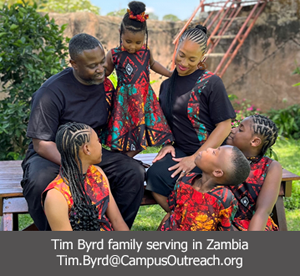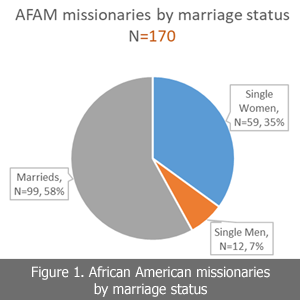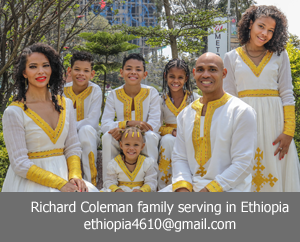|
 This is part 2 from the article “African American missionaries serving overseas: A surprising numerical and demographic analysis of US-born Blacks in missions” by Jim Sutherland, Richard Coleman and Jacinta Russel. This appeared in the May 2023 edition of "Missiology: An International Review." Please go to the following link for the full article and bibliography: https://rmni.org/files/afam/HistoryandResearch/African-American-Missionaries-Serving-Overseas.pdf This is part 2 from the article “African American missionaries serving overseas: A surprising numerical and demographic analysis of US-born Blacks in missions” by Jim Sutherland, Richard Coleman and Jacinta Russel. This appeared in the May 2023 edition of "Missiology: An International Review." Please go to the following link for the full article and bibliography: https://rmni.org/files/afam/HistoryandResearch/African-American-Missionaries-Serving-Overseas.pdf
The website of Reconciliation Ministries Network (RMNI.org) has had our AFAM missionary survey form on it since 2008, which some missionaries completed, while others simply used our “Contact” page. The 102 cross-cultural missionaries located in Sutherland’s 1998 survey were also checked to see if they were still in full-time overseas mission work.
An effort was made in 2015 to contact the most likely mission agencies listed in the 15th (1993-95) edition of the Mission Handbook, which lists probably the majority of well-established agencies. This was done using email, phone calls and agency websites. Approximately 562 agencies were contacted between April 2013 and June 2016, primarily those listed as Baptist, Evangelical, Fundamentalist and Independent, and that data was entered into an Excel database.
A second effort was made between August 2018 and December 2020 to directly contact or to carefully examine websites of agencies (except Canadian and small overseas-based agencies), based upon listings in the 2017-2019 22nd edition of the Mission Handbook, which represents 2016 data. This time all categories of agencies were included, except Canadian-based, and totaled 639. Larger agencies were contacted more often, due to their influence upon totals. If a large agency did not post missionary photos or sufficient bio information, information that the agency did release was used. Facebook and LinkedIn were especially helpful to verify a person’s current status, although information may not have been updated. An imperfect verification method was to see if a person had an active account to receive donations.
We asked agencies if they currently had any US-born Blacks serving with them fulltime overseas, for at least two years. We inquired after country location, the kind of ministry performed, and requested a first name, to avoid duplications. For missionaries working in sensitive areas, we asked for the global region served, not the country. As mentioned, we did not include those working in the US mission office, to be in line with Mission Handbook overseas statistics.
While significant help was received from White mission personnel, indispensable was assistance from Black colleagues who helped specially to locate missionaries not affiliated with an agency. Leads were provided by members of the Operation Mobilization Roundtable, which has focused upon AFAM mission mobilization for several years. Members of the COMINAD (Cooperative Mission Network of the African Dispersion) Facebook group provided missionary contacts. The Assemblies of God AFAM mission mobilizers provided excellent help, as have many mission executives. AFAM missionaries also provided many leads, as did numerous AFAM mission mobilizers.
The data set was fixed after a good-faith effort was made to contact or investigate all relevant US agencies listed in the 22nd edition of the Mission Handbook. We then verified that all missionaries who fit the parameters, regardless of when located, were still on the field between March 2020 and June 2021—our data set. Of course, it is impossible for a data set to be totally valid at any one point in time, since there is no real-time central database.
The biggest hindrance to gathering information is ever-tightening security and personnel policies. Some large agencies, particularly those working in sensitive areas, would provide little or no information, despite a promise of anonymity. Others simply did not respond to inquiries made on their website contact forms. One large global agency has no central database even of its own missionaries, so it was necessary to contact many of their global branches.
We do not claim to have located all AFAM overseas missionaries, but our data is generally in line with earlier-mentioned research. Our data supports the consensus among mobilizers who are of various ethnicities, and among many mission executives, that AFAM missionaries are difficult to recruit.
Findings
Marriage status
Of the 179 located missionaries, 25 couples with both spouses are in our database. There are 71 confirmed singles. The marriage status of another 9 could not be confirmed.
Fully 42% of overseas missionaries in our AFAM population are single, compared to 19% of all field workers in the 22nd Handbook survey (Newell, 2017: 48, 52). The ratio of female to male singles shows more females in our group, at 83% women and 17% men, versus 72% women and 28% men in the overall 22nd Handbook population. This reflects fewer AFAM marrieds nationally than in the total US Protestant missionary population (Newell, 2017: 51). As of 2021, 54.7% of White men, 45.8% of Hispanic men and 36.8% of Black men were married (USA Facts, 2022). Among women, 52.6% of Whites, 48.1% of Hispanics and 32.4% of Black women were married (USA Facts, 2022).
As of 2015, 17% of US newlywed couples were interethnic (Livingston G and Brown A, 2017). According to US Census figures, approximately 10% of US marriages were interethnic by 2016 (Rico B et al., 2018). An astonishing 57% of the 74 marriages represented in our study are interethnic marriages—a US-born Black married to someone who is not a US-born Black. These inter-racial/ethnic marriages are easily noticed by photos of missionaries on agency websites, social media and missionary communications. Some may be disqualified by obvious foreign language accents on videos, and others verified by those who personally know them. Such verifications are not foolproof.
According to Kenney and Kenney (2012: 101-103, 108), it is well documented that biracial couples have been challenged for being such. They have experienced ‘societal hostility’, ‘rejection’, and ‘discrimination’. These couples have embraced different worldviews and cultural backgrounds within their marriages. Such a background would tend to prepare them to handle conflict, and to sensitize them to other worldviews and cultures more than would be the case with monocultural couples. That a majority of the 74 marriages of AFAM missionaries are interethnic should alert recruiters to the potential of interracial couples for overseas ministry. Since the second greatest hindrance to AFAMs getting to the field, mentioned in Sutherland’s 1998 research (1998: 167-170) was difficulty raising financial support--having wider church connections by marriage may also be an advantage. This is more fully illustrated below.
Ministry location
The country or geographical region of service is known for all but one missionary. As shown in Figure 2, Africa is the destination of choice. According to a 2021 Pew Report, among Blacks, 55% said that their origin was central to their identity, compared with 23% of Whites (Cohn D et al., 2021). Some consider Africa their mother continent and want to help.
Accordingly, 46% percent (N=83) are based in Africa, compared to 21% of all US and Canadian missionaries in the 22nd Handbook (Newell, 2017: 63). Of these, 16 serve in Kenya, or 9% of the total AFAM missionary population. Twenty percent of AFAM missionaries in our data are in Asia, compared with 36% in the 22nd Handbook population. Twenty-three percent of AFAM missionaries are in majority Muslim, Buddhist or Hindu areas, or where Christianity is not the major religion (Central/SE/East Asia, Middle East—N=41), but another 12 work with Muslims throughout Africa (N=8) and Europe (N=4), bringing the total to 53, or 30% of the total missionary force. Three missionaries not in the database for security reasons are also in Africa, N. Africa or the Middle East, which would bring the total to 31%. Agencies would do well to consider AFAM candidates for these areas of service. At least in the Middle East and Africa, they are less obtrusive than Whites due to skin color. Of the 26 working in 12 European nations, France, England and Spain receive the most missionaries (6, 5 and 3, respectively). Seventeen missionaries serve in Central and South America. In the “Other” category, 5 of the 12 serve in Oceana, 5 work in Mexico, one works in Canada, while one’s area is unknown.
The 22nd Handbook initiated the regional category “North America” to include cross-cultural ministry there, which comprised 1% of all their missionary population (Newell, 2017: 63). While this study focuses upon overseas missionaries, we verified another 68 missionaries working primarily cross-culturally within the USA by 2021. If we included them, they would be 28% of a total of 245 AFAM cross-cultural workers.  Work within the US is easier compared with the complications of living abroad, including separation from extended family. Of course, with increased immigration into the US, cross-cultural stateside ministry is certainly appropriate. Work within the US is easier compared with the complications of living abroad, including separation from extended family. Of course, with increased immigration into the US, cross-cultural stateside ministry is certainly appropriate.
Kinds of ministry
The three largest categories of ministry in Figure 3 comprise 46% of the primary ministries of the 153 AFAM overseas missionary “units” (of the 179 missionaries in our database) for whom we have this kind of information. In the 22nd Handbook data, of 627 agencies, 46% indicate that one of those 3 categories is their primary activity, clearly matching the top “primary activities” of North American agencies (Newell, 2017: 59). Our social work category includes protecting women (4), trauma counseling (3), refugee work (2), and promoting justice (2). The “Other” category includes 3 doing Business as Mission (BAM). Often mission is highly relational--one-to-one--as was Jesus’ ministry, and over 90% of ministries identified are of that nature.

|